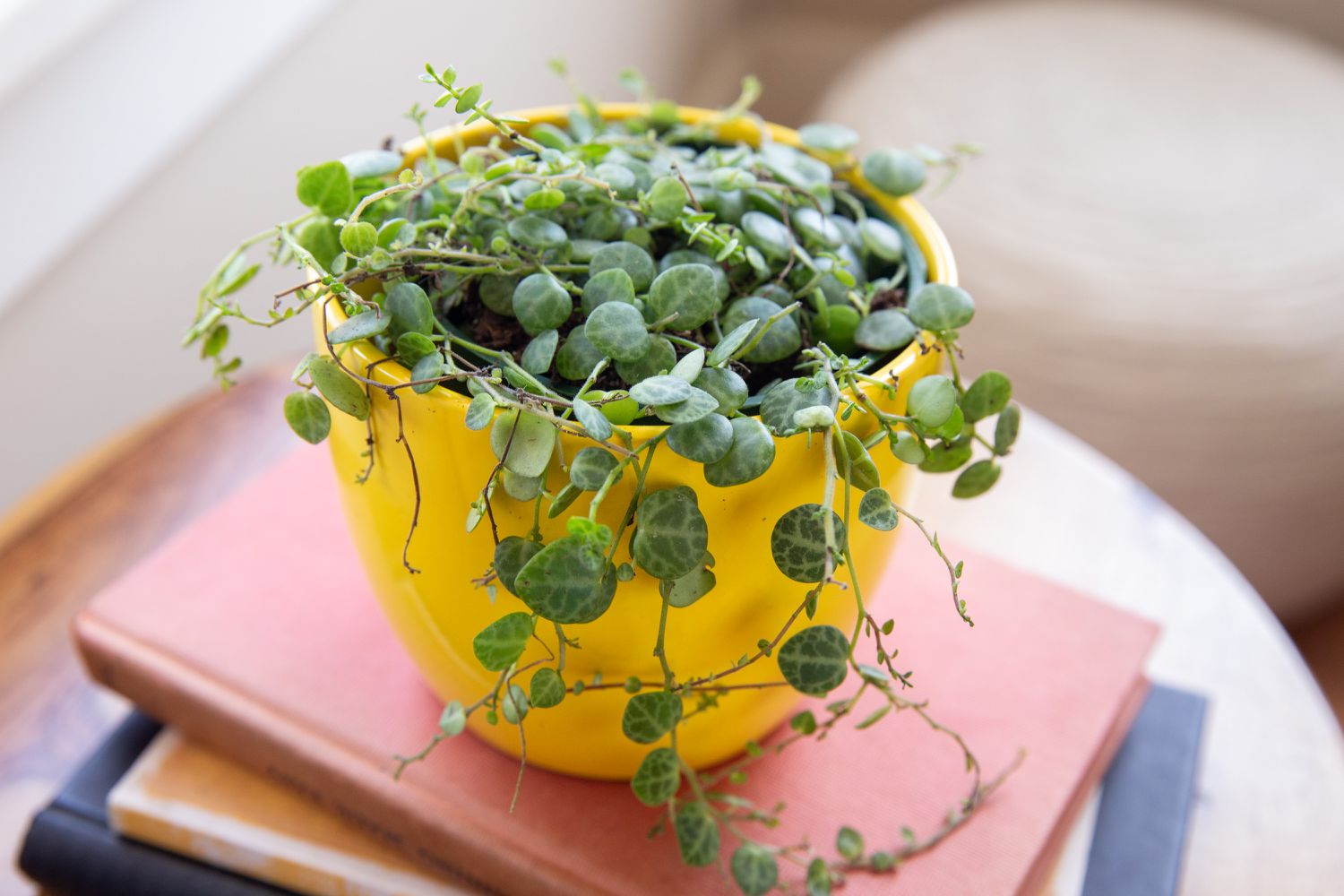To care for a String of Turtles, provide bright indirect light and water when the soil is dry. String of Turtles is a unique and eye-catching succulent that requires specific care to thrive in your home.
With its distinctive turtle-like patterned leaves, this plant adds a touch of whimsy to any indoor space. By following a few simple care tips, you can ensure your String of Turtles remains healthy and vibrant. We will explore the best practices for caring for your String of Turtles plant, including light requirements, watering needs, soil preferences, and common issues to watch out for.
By understanding how to care for this charming succulent, you can enjoy its beauty for years to come.

Credit: plantly.io
Ideal Growing Conditions
Light Requirements
String of Turtles plants thrive in bright, indirect light. Place them near a window with filtered sunlight.
Temperature And Humidity Needs
Keep the temperature around 65-75°F and maintain high humidity levels by misting the plant regularly.
Watering And Soil
To care for a string of turtles, it is important to ensure that the soil is well-draining and the plant is watered only when the soil is dry to the touch. Overwatering can lead to root rot and other issues, so it is important to monitor the soil and water accordingly.
String of turtles, also known as Peperomia prostrata, is a charming trailing plant that is easy to care for and perfect for indoor spaces. Like all plants, string of turtles requires proper watering and soil to thrive. In this article, we will discuss the best practices for watering and soil to keep your string of turtles happy and healthy.Proper Watering Techniques
When it comes to watering your string of turtles, it’s important to strike a balance between too much and too little water. Overwatering can lead to root rot, while underwatering can cause the plant to dry out and die. Here are some tips to help you water your string of turtles correctly:- Water your plant when the top inch of soil feels dry to the touch
- Water the plant thoroughly, until water drains out of the bottom of the pot
- Empty the saucer underneath the pot to prevent the plant from sitting in standing water
- Avoid getting water on the leaves, as this can cause them to rot
Choosing The Right Soil
Choosing the right soil is crucial for the health of your string of turtles. The plant needs well-draining soil that allows water to flow through easily and does not retain moisture. Here are some tips for choosing the right soil:| Soil Type | Pros | Cons |
|---|---|---|
| Peat moss-based soil | Retains moisture well | May become compacted over time |
| Perlite-based soil | Provides excellent drainage | May dry out quickly |
| Succulent or cactus soil | Provides good drainage | May contain too much sand |
Propagation
Propagation is a crucial part of caring for a string of turtles plant. It involves the process of creating new plants from the parent plant, allowing you to expand your collection or share with friends and family. There are a few different methods of propagation that can be used to multiply your string of turtles plant.
Methods Of Propagation
There are two primary methods of propagating string of turtles: division and stem cuttings. Division involves separating the plant into smaller sections, each with its own roots, while stem cuttings involve taking a cutting from the mother plant and encouraging it to grow roots.
Tips For Successful Propagation
- When propagating through division, ensure that each section has its own roots to support its growth.
- For stem cuttings, select a healthy, mature stem and take a cutting just below a leaf node. Remove the lower leaves to expose the node, which will encourage root growth.
- Place the division or cutting in well-draining soil, and keep it in a warm, bright location with indirect sunlight. Mist the soil lightly to keep it moist, but not waterlogged.
- Consider using a rooting hormone to encourage faster root development in stem cuttings.
- Monitor the propagation regularly to ensure that the soil remains moist and the new plant is establishing itself.
Pruning And Maintenance
When it comes to caring for your string of turtles plant, it’s essential to understand the importance of pruning and maintenance. Proper pruning and maintenance play a vital role in keeping your plant healthy, vibrant, and thriving. In this section, we will provide valuable guidance on trimming, common issues, and troubleshooting to help you ensure the well-being of your string of turtles.
Trimming Guidance
Trimming your string of turtles plant is crucial for maintaining its compact and bushy appearance. Here are some essential guidelines to follow when pruning your plant:
- Use clean, sharp scissors or pruning shears: Ensure your cutting tools are sanitized to prevent the spread of diseases.
- Remove leggy or discolored stems: Trim any overgrown or unhealthy stems to promote new growth and maintain the plant’s shape.
- Prune selectively: Focus on removing specific stems or branches rather than shearing the entire plant to avoid causing stress.
- Allow for recovery time: After trimming, give your plant adequate time to recover and regrow before further pruning.
Common Issues And Troubleshooting
Despite your best efforts, your string of turtles plant may encounter some common issues. Here are some troubleshooting tips to address potential problems:
- Yellowing or drooping leaves: Check the soil moisture and adjust your watering routine accordingly. Ensure proper drainage to prevent root rot.
- Leggy growth or sparse appearance: Provide adequate sunlight and consider rotating the plant to promote even growth and prevent stretching.
- Pest infestation: Inspect your plant regularly for pests such as spider mites or mealybugs. Use natural remedies or insecticidal soap to control infes
Pests And Diseases
When it comes to caring for a string of turtles, it’s important to be vigilant about potential pests and diseases that can affect the plant. Identifying common pests and diseases, as well as implementing preventive measures and treatments, is crucial for maintaining the health and vitality of your string of turtles.
Identifying Common Pests
Common pests that may affect string of turtles include spider mites, mealybugs, and aphids. These pests can cause damage to the plant by sucking sap from the leaves, leading to wilting, yellowing, and stunted growth. To identify these pests, carefully inspect the leaves and stems of the plant for any signs of infestation, such as webbing, white cottony masses, or small, pear-shaped insects.
Preventive Measures And Treatments
To prevent pest infestations, it’s important to regularly inspect your string of turtles and maintain a clean growing environment. Wiping the leaves with a damp cloth and regularly spraying the plant with a neem oil solution can help deter pests. If an infestation occurs, you can treat the plant with insecticidal soap or horticultural oil, following the manufacturer’s instructions carefully.

Credit: www.youtube.com
Repotting
Repotting is an essential part of caring for a String of Turtles plant. As the plant grows, it will eventually outgrow its current pot, and repotting is necessary to ensure its continued health and vitality.
Signs That It’s Time To Repot
It’s important to keep an eye out for signs that your String of Turtles plant needs repotting. If you notice roots growing out of the drainage holes or the plant becoming too large for its current pot, it’s time to repot. Additionally, if the soil dries out very quickly after watering, it may indicate that the roots have taken up most of the space in the pot and the plant needs a larger container.
Steps For Repotting
When repotting your String of Turtles plant, it’s important to follow a few key steps to ensure a smooth transition and minimal stress on the plant. First, carefully remove the plant from its current pot, being mindful not to damage the delicate stems and leaves. Next, gently loosen the roots and remove any old, compacted soil. Then, select a new pot that is 1-2 inches larger in diameter than the current one and has good drainage. After placing some fresh, well-draining potting mix in the new pot, carefully place the plant in the center and fill in the gaps with more soil. Finally, water the plant thoroughly and allow any excess water to drain away.

Credit: www.lovethatleaf.co.nz
Conclusion
To sum up, caring for your String of Turtles plant requires attention to watering, lighting, and soil. By following these simple guidelines, you can ensure the health and beauty of your plant for years to come. Remember, a little care goes a long way in nurturing your green companion.





Leave a Reply